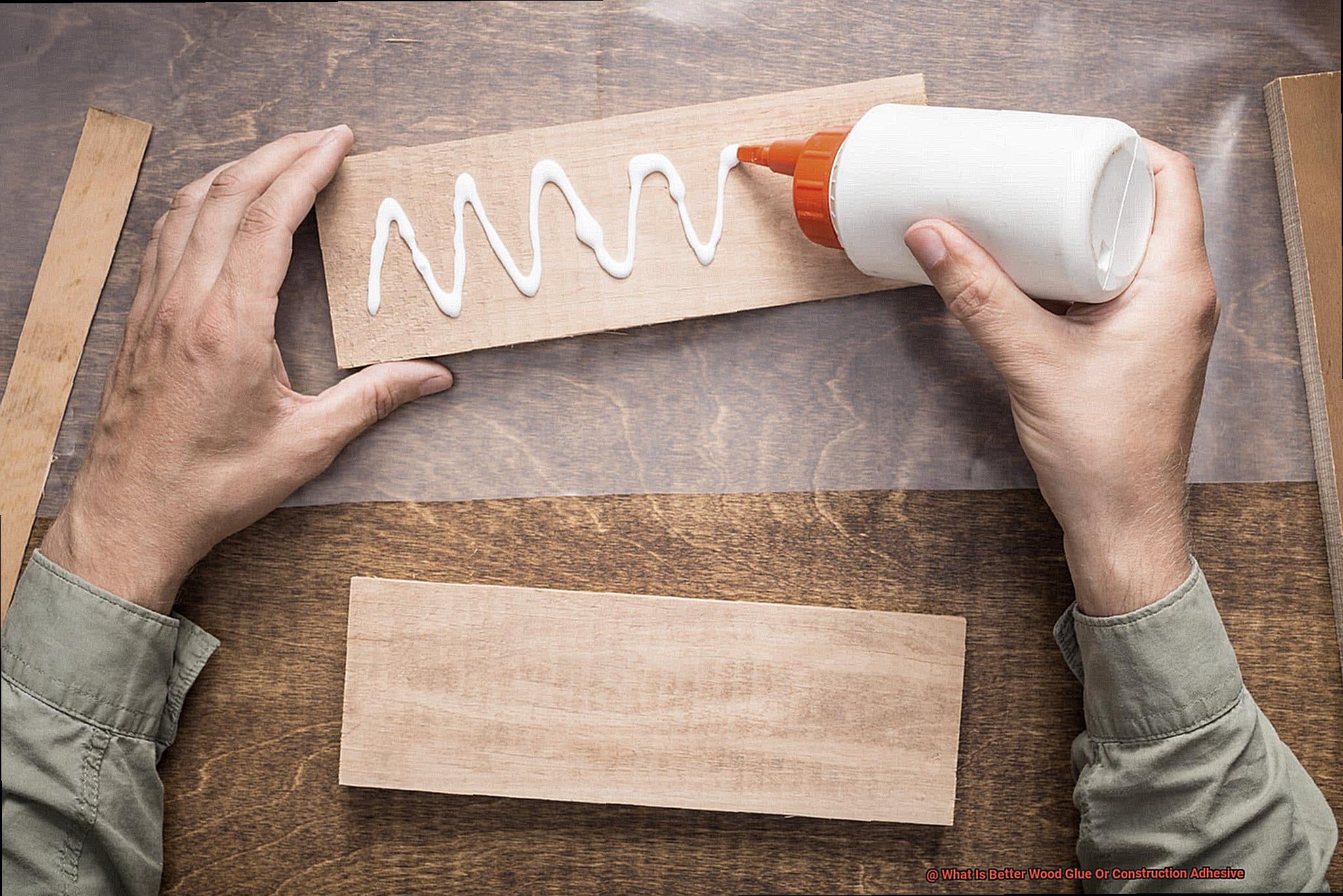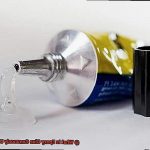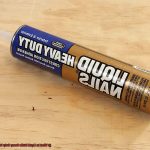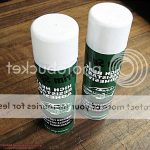Are you a woodworking enthusiast looking for the perfect adhesive to make your projects rock-solid? Well, look no further. In this blog post, we’re going to tackle the age-old debate: wood glue vs. construction adhesive.
Wood glue, the trusty companion of crafters everywhere, is known for its unbeatable bond and user-friendly nature. It’s like the reliable best friend who always has your back during those smaller projects. On the other hand, construction adhesive is like the tough guy in town – it sticks to any surface and can handle even the harshest conditions.
So, which one should you choose? Join me as we delve into the pros and cons of these two adhesives and discover which one reigns supreme in the world of woodworking. Get ready to make an informed decision that will take your projects to new heights.
What is Wood Glue?
Contents
Wood glue, also known as carpenter’s glue or woodworking adhesive, is a magical substance that holds the world of woodworking together. Whether you’re a seasoned craftsman or a DIY enthusiast, understanding the properties and uses of wood glue can greatly enhance your woodworking projects. In this blog post, we will explore the wonders of wood glue and how it can help you create sturdy and beautiful wooden structures.
The Power of Penetration and Bonding:
Wood glue possesses a remarkable ability to penetrate deep into the porous surface of wood, creating a bond that defies time. Its water-based emulsion of polyvinyl acetate (PVA) ensures that the adhesive seeps into the wood fibers, forming a connection resistant to moisture and temperature changes. This deep penetration allows wood glue to create a bond that can withstand the test of time.
Types of Wood Glue:
Wood glue comes in various forms to suit different woodworking needs. Liquid wood glue, with its ease of application and quick bonding properties, is the most commonly used type. For vertical applications and gap-filling tasks, gel wood glue with its thicker consistency is perfect. And for large-scale projects, powdered wood glue mixed with water provides a cost-effective solution.
Using Wood Glue Effectively:
To achieve optimal results with wood glue, proper surface preparation is essential. Ensure that the surfaces are clean and free from any contaminants that could hinder bonding. Applying pressure to the glued joint while the glue is drying helps ensure a strong bond. Clamps or clamping devices are often used to hold the pieces together until the glue fully cures.
Versatility in Woodworking Projects:
Wood glue’s versatility makes it indispensable in various woodworking applications. It excels at bonding wooden joints found in furniture, cabinets, and decorative wooden pieces. Whether you’re creating intricate woodwork or repairing broken furniture, wood glue is your go-to adhesive.
Strength Matters:
While wood glue provides excellent bonding capabilities for most woodworking projects, several factors can affect the strength of the bond. The type of wood, quality of the glue, and application technique all play a role in determining the final strength. By following the manufacturer’s instructions and selecting a high-quality wood glue, you can achieve durable and long-lasting bonds.
What is Construction Adhesive?
In the realm of construction, a formidable force reigns supreme – construction adhesive. This magical substance possesses the power to unite and fortify structures, making it an indispensable tool for both DIY enthusiasts and seasoned builders. In this enlightening article, we will embark on a captivating journey into the world of construction adhesive, unraveling its manifold types, boundless applications, unrivaled advantages, and vital safety precautions.
Types of Construction Adhesive:
- Solvent-Based Adhesive: Boasting rapid drying capabilities and immense initial strength, solvent-based adhesives are the go-to choice for heavy-duty applications and bonding formidable materials like metal and concrete.
- Water-Based Adhesive: Embracing an eco-friendly nature and effortless cleanup, water-based adhesives prove their versatility by forging robust bonds across an array of materials while maintaining exceptional flexibility.
- Hybrid Adhesive: Uniting the finest qualities of solvent-based and water-based adhesives, hybrid adhesives offer an unparalleled amalgamation of bonding strength, flexibility, and resistance to moisture.
Applications and Advantages:
- Woodworking Wonder: Construction adhesive serves as the trusted ally in woodworking projects by expertly bonding joints, veneers, laminates, and trim pieces. Its remarkable gap-filling properties ensure a steadfast connection even on uneven surfaces.
- Tile Installation Triumph: When it comes to tile installation, construction adhesive emerges as a reliable champion for securing tiles to walls or floors. Its superior water-resistance thwarts loosening caused by moisture exposure.
- Concrete and Masonry Marvels: In masonry projects requiring the union of concrete blocks or stones, construction adhesive stands tall, offering extraordinary strength and unwavering durability that defy the ravages of time and external forces.
- Drywall Domination: By fortifying the bond between drywall panels and framing members, construction adhesive reinforces drywall installations, minimizing the risk of sagging or cracking as the years pass.
Safety Precautions:
- Embrace the Breath of Fresh Air: Proper ventilation is paramount when working with construction adhesive, as certain types may emit fumes during application. Ensure a steady influx of fresh air in your workspace to safeguard against respiratory issues.
- Shield and Safeguard: Don protective gloves and safety glasses to shield your skin and eyes from potential irritation caused by construction adhesive.
- The Path to Responsible Progress: Comply with the manufacturer’s instructions for proper storage and disposal of construction adhesive, demonstrating a commitment to safety and environmental responsibility.


Main Differences Between Wood Glue and Construction Adhesive
Today, we delve into the captivating realm of adhesives, where two titans battle it out for supremacy – wood glue and construction adhesive. Let’s explore the fundamental differences between these adhesive powerhouses and uncover which one will reign supreme in your next project.
Composition Clash:
Wood glue, also known as carpenter’s glue, is forged from a water-based polymer, rendering it perfect for bonding porous materials like wood. Conversely, construction adhesive is a synthetic polymer-based adhesive that conquers a vast array of surfaces, including wood, metal, concrete, and plastic. Picture wood glue as the specialist and construction adhesive as the versatile all-rounder.
Drying Time Duel:
In the realm of drying time, wood glue emerges as the agile sprinter, typically setting within 30 minutes to an hour. It’s a flawless choice for projects necessitating swift assembly or clamping. In contrast, construction adhesive takes its time to fully cure, often requiring several hours or even overnight to establish an unyielding bond. Patience becomes a virtue here, but the wait rewards with enhanced penetration and an unbreakable connection.
Strength Showdown:
When it comes to strength, construction adhesive flexes its muscles and emerges as the undisputed victor. This formidable adhesive is engineered to withstand hefty loads and resist moisture, making it ideal for structural applications such as framing or countertop installation. While wood glue does offer a robust bond for woodworking projects, it may not possess the same durability or moisture resistance as construction adhesive.
Flexibility Finale:
While wood glue hardens to concrete-like rigidity after drying, which is advantageous for certain applications craving stiffness, construction adhesive triumphs in the flexibility arena. Its ability to retain flexibility after drying allows for expansion and movement without compromising the bond, making it perfect for installing trim or molding.
Application Adventure:
Both wood glue and construction adhesive can be applied similarly, but due to its thick and viscous nature, construction adhesive often necessitates a caulk gun for precise dispensing. Spread the adhesive evenly using a brush or putty knife, ensuring an even distribution of adhesive magic.
When to Use Wood Glue
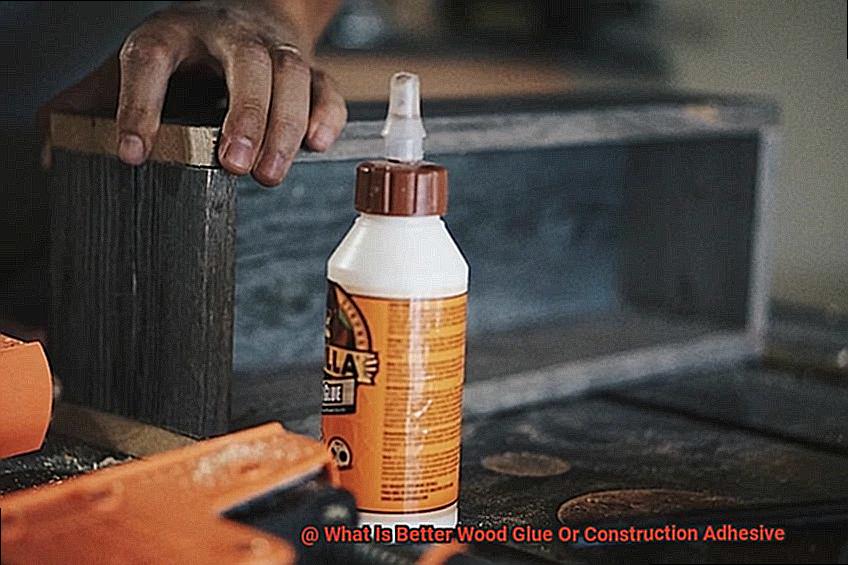
Wood glue is a versatile and reliable adhesive that is essential for many woodworking projects. Whether you are constructing furniture, cabinets, or engaging in carpentry work, wood glue is the go-to option for joining wood pieces securely.
One of the key advantages of wood glue is its ability to bond different types of joints. Whether you are working with butt joints, rabbet joints, dado joints, or mitre joints, wood glue forms a strong and durable bond that can withstand the test of time. This makes it an ideal choice for projects where strength and longevity are important.
Wood glue is specifically designed for porous surfaces, such as raw or unfinished wood. It deeply penetrates the wood fibers, creating a bond that is both strong and long-lasting. However, it is important to note that wood glue is not suitable for non-porous surfaces like metal or plastic, as it will not adhere well.
In addition to its bonding capabilities, wood glue also offers the advantage of drying clear. This means that it is perfect for projects where the adhesive needs to be invisible. Whether you are working on high-quality woodworking projects or simply want to maintain the natural beauty of the wood, wood glue provides a seamless finish.
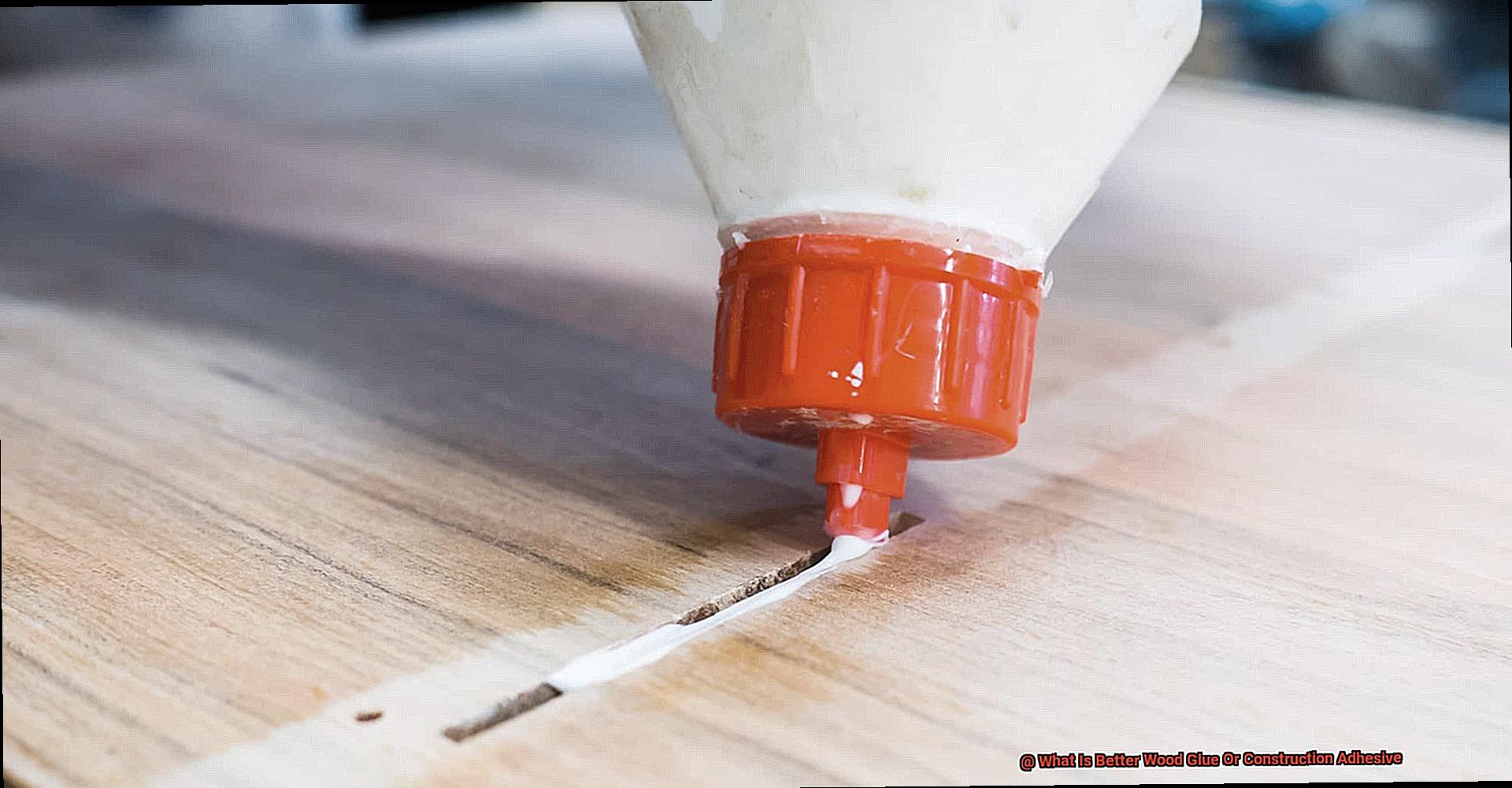
Another benefit of wood glue is its relatively quick setting time. Once applied, it begins to set quickly, allowing you to clamp or hold the glued pieces in place until the bond sets. This ensures a secure and stable connection between the wood pieces.
However, it is important to note that using pressure is necessary when using wood glue. To create a strong bond, clamps or weights should be used to hold the pieces together while the glue dries. This ensures that the adhesive is evenly distributed and maximizes the strength of the bond.
When choosing a wood glue, it is important to consider the drying time and strength of different types. Some glues may dry faster than others or offer stronger bonds depending on your specific project requirements. It is always recommended to choose a wood glue that suits your needs and ensures the best results.
While wood glue is an excellent choice for many woodworking projects, it is worth noting that it may not be suitable for applications where flexibility is required. Over time, wood glue tends to become brittle, which may affect its ability to withstand movements or vibrations.
When to Use Construction Adhesive
Choosing the right adhesive for your construction project can be a daunting task. With so many options available, it’s important to understand when to use construction adhesive and why it’s the star of the show. So, let’s dive into the world of construction adhesive and explore its versatility and power.
First and foremost, construction adhesive is a true team player when it comes to bonding materials. Whether you’re working with wood, metal, concrete, or plastic, this adhesive can handle it all. It’s like the superhero of adhesives, ready to bond different materials together with a strength that can withstand any challenge.
Speaking of strength, construction adhesive is built to last. It flexes its muscles under heavy loads and extreme weather conditions, making it the perfect choice for both indoor and outdoor projects. If you need a bond that can handle some serious weight or stand up to Mother Nature’s fury, construction adhesive is your go-to.
But that’s not all – construction adhesive is also a time-saver. Unlike wood glue, which requires clamping and drying time, construction adhesive bonds quickly and securely without any extra support. It’s ideal for those moments when you need a speedy bond to keep your project on track.
And let’s not forget about aesthetics. Construction adhesive can be your secret weapon for achieving a seamless and clean appearance. Whether you’re attaching trim or molding to a wall or ceiling, using construction adhesive ensures a professional finish without the need for visible nails or screws. It’s like magic.
But wait, there’s more. Construction adhesive doesn’t just bond materials together; it also fills gaps and cracks. If your surfaces aren’t perfectly aligned or have imperfections, this adhesive comes to the rescue by filling in those gaps before creating a strong bond. It’s like giving your project a little extra love to ensure a flawless end result.
However, it’s worth mentioning that while construction adhesive offers numerous benefits, there are still instances where wood glue steals the show. Wood glue excels in precision woodworking projects where fine detailing and a clear finish are essential.
Different Types of Wood Glue
Mastering the craft of woodworking requires not only skillful hands but also the right tools. One indispensable tool in a woodworker’s arsenal is wood glue. However, with an overwhelming array of options available, selecting the ideal wood glue for your project can be a daunting task. Fear not, for this guide will delve into the distinctive characteristics and pros and cons of different types of wood glue, empowering you to make an informed decision.
PVA Glue – The Versatile Powerhouse:
Polyvinyl acetate (PVA) glue, also known as yellow glue or carpenter’s glue, reigns supreme as the most ubiquitous wood glue. This water-based adhesive offers ease of use and delivers a robust bond. Perfect for most woodworking projects, PVA glue excels at joining wood surfaces together. However, it may fall short when confronted with moisture or extreme temperature fluctuations.
Epoxy Adhesive – The Unyielding Champion:
Epoxy adhesive, a dynamic duo composed of resin and hardener, emerges as an unparalleled force in bonding strength. Its enduring power withstands heat, water, and chemicals with remarkable resilience. Unsurprisingly, epoxy adhesive is the go-to choice for fusing difficult-to-glue woods or remedying gaps in wood joints. Nonetheless, its application demands meticulous mixing and careful execution to avoid messiness.
Polyurethane Glue – The Indomitable Outdoor Warrior:
Polyurethane glue, famously known as Gorilla Glue, boasts a unique composition that expands during curing. This remarkable adhesive fills gaps seamlessly while forging an unyielding bond. Its resistance to water, heat, and solvents makes it an unrivaled choice for outdoor applications or projects exposed to moisture. Beware though—cleaning up excess glue before it dries can be an arduous task.
Cyanoacrylate Glue – The Swift Fixer:
Cyanoacrylate glue, affectionately termed super glue or CA glue, is the epitome of rapidity, forming an instantaneous bond. Perfect for small repairs or bonding non-porous materials like metal and plastic, CA glue offers convenience and efficiency. However, be cautious when considering it for woodworking projects, as it may become brittle over time and may not possess the same robustness as other wood glues.
Different Types of Construction Adhesive
When it comes to bonding materials in construction or woodworking projects, choosing the right adhesive is crucial. Two popular options are wood glue and construction adhesive. In this article, we will explore the different types of construction adhesives available on the market and compare them with wood glue to help you make an informed decision for your specific needs.
Polyurethane Adhesive:
Polyurethane adhesive is a versatile option that offers excellent adhesion and flexibility. It is commonly used for bonding a wide range of materials, including wood, metal, concrete, and plastic. What sets polyurethane adhesive apart is its resistance to moisture and temperature changes, making it suitable for outdoor or high-humidity environments. Its ability to withstand harsh conditions makes it a preferred choice for construction projects that require durability and strength.
Epoxy Adhesive:
Epoxy adhesive is renowned for its exceptional strength and durability. It consists of two parts – a resin and a hardener – that chemically react to form a strong bond. Epoxy adhesive is commonly used for heavy-duty applications, such as bonding metal or stone. Its high resistance to chemicals and extreme conditions makes it ideal for projects that demand maximum strength.
Silicone Adhesive:
Silicone adhesive contains silicone as its primary component, making it highly resistant to temperature extremes, moisture, and UV radiation. This type of adhesive is often used for sealing and bonding applications in areas that require flexibility, such as windows, doors, and plumbing fixtures. Silicone adhesive provides a long-lasting bond that remains flexible over time.
Acrylic Adhesive:
Acrylic adhesive is a versatile construction adhesive that offers good bonding strength and durability. It is commonly used for bonding materials like plastic, metal, and glass. Acrylic adhesive dries quickly and forms a transparent bond, making it ideal for applications where aesthetics are important. It is also resistant to water and weathering.
Choosing the Right Adhesive:
To choose the right adhesive for your project, consider the specific requirements. Wood glue, like PVA glue, is designed specifically for bonding wood surfaces and offers a strong bond with some flexibility. Construction adhesives, on the other hand, offer versatility and durability for a wide range of materials. Consider factors such as bonding strength, durability, flexibility, and resistance to environmental conditions when making your decision.
ZvtOSVpcvrk” >
Also Read: How To Glue Wood To Concrete Without Drilling?
Conclusion
In conclusion, when it comes to deciding between wood glue and construction adhesive, it ultimately depends on the specific project and materials being used. Wood glue is a tried and true option for bonding wood surfaces together, offering strong adhesion and flexibility. On the other hand, construction adhesive is designed for a broader range of applications, providing excellent bonding strength for various materials like metal, concrete, and plastic.
If you’re working on a woodworking project where wood-to-wood bonding is the primary concern, wood glue is often the preferred choice. Its ability to penetrate porous surfaces and create a strong bond makes it ideal for joining pieces of wood together securely. Additionally, wood glue offers some level of flexibility, allowing the bonded joints to withstand changes in temperature and humidity without cracking or breaking.
However, if your project involves different materials or requires a more robust bond, construction adhesive may be the better option. Construction adhesive is formulated to provide exceptional strength and durability across various surfaces. It can effectively bond not only wood but also materials like metal, concrete, plastic, and even stone. This versatility makes construction adhesive suitable for a wide range of projects such as installing drywall or securing trim pieces.
It’s important to note that both wood glue and construction adhesive have their strengths and weaknesses. Wood glue typically takes longer to cure fully compared to construction adhesive which often sets quickly. This means that if you need an immediate bond or are working with non-porous surfaces that don’t absorb moisture well, construction adhesive might be more suitable.
In summary, choosing between wood glue and construction adhesive ultimately depends on the specific requirements of your project. Consider factors such as the materials involved, desired bonding strength, curing time needed, and overall versatility required.

